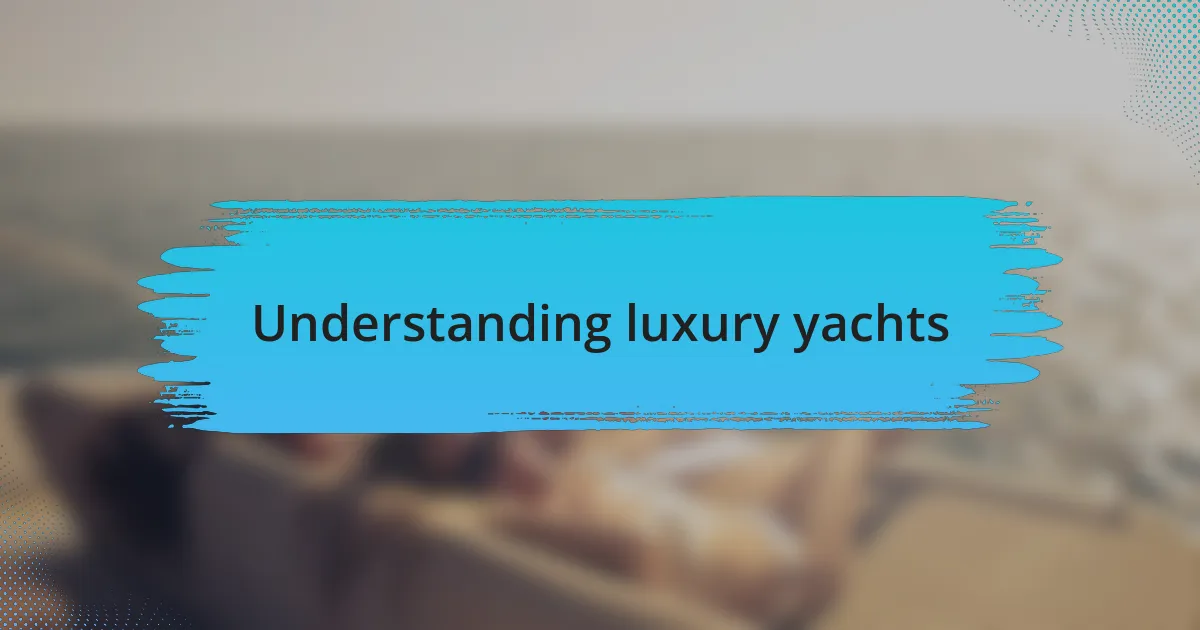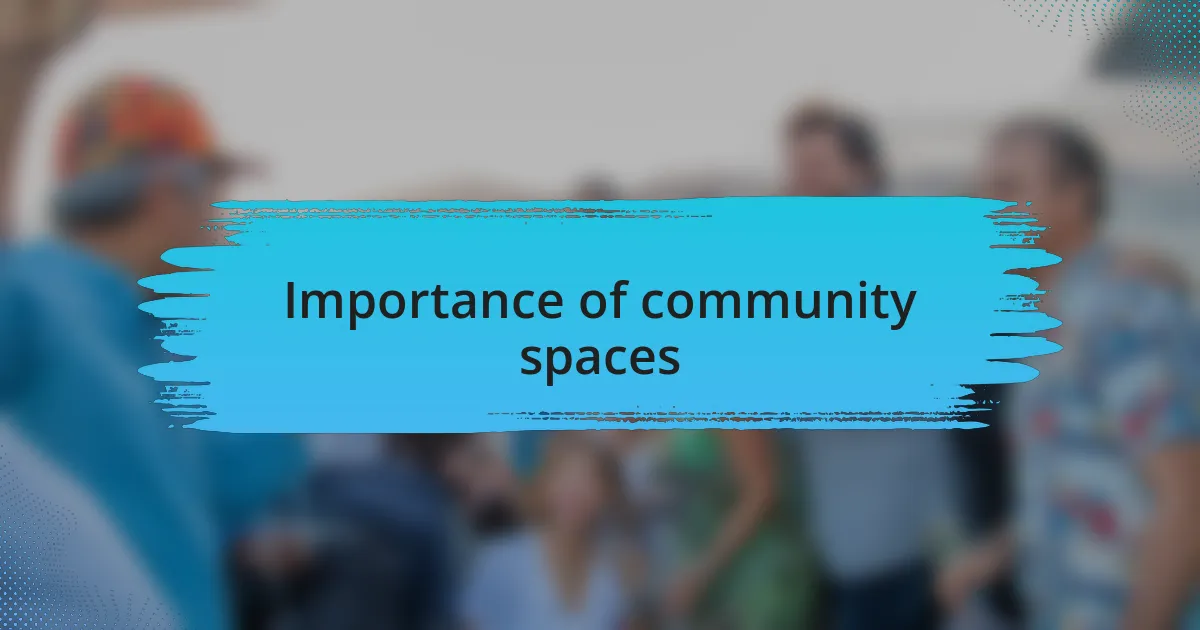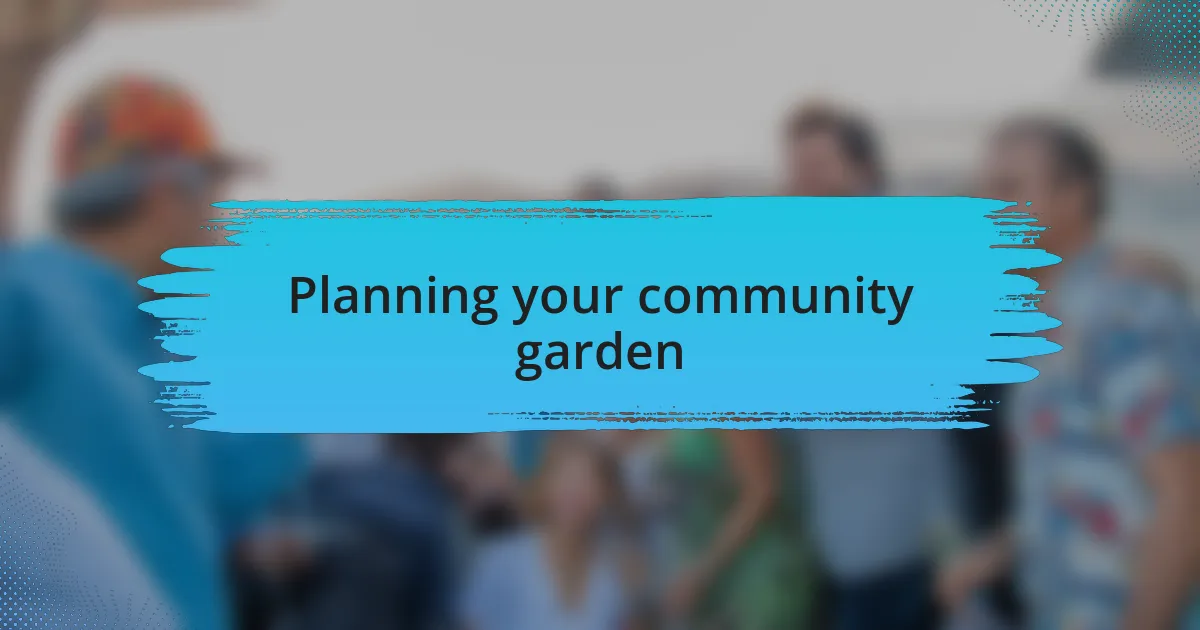Key takeaways:
- Luxury yachts embody a lifestyle of personalization and community experiences, transforming them into floating homes for social gatherings.
- Community spaces, such as parks and gardens, foster connections and promote well-being, strengthening neighborhood ties.
- Community gardens provide educational opportunities and are effective in building social bonds while teaching sustainability.
- Engaging the community in gardening involves collaboration and utilizing platforms like social media to enhance participation and celebrate shared successes.

Understanding luxury yachts
Luxury yachts represent not just a mode of transportation, but a lifestyle choice that reflects personal taste and aspiration. I remember the first time I stepped aboard a friend’s luxury yacht; the feeling of opulence was overwhelming. The polished wood, exquisite furnishings, and attention to detail didn’t just speak of wealth—they told a story of comfort and adventure.
When considering what makes a yacht truly luxurious, it often comes down to customization. Have you ever thought about how much personal touch goes into designing these vessels? From bespoke interiors that reflect the owner’s personality to advanced navigation systems, each element can be carefully tailored. I once met a yacht owner who incorporated local artwork into his yacht’s design, making it a traveling gallery that celebrated culture as much as luxury.
Many people might think that luxury yachting is only for the elite, but I believe it’s more about the experiences shared on the water. Imagine hosting a gathering at sunset, where laughter mingles with the sound of waves. That sense of community can easily transform a yacht from a mere vessel to a floating home that brings people together in a truly exquisite setting.

Importance of community spaces
Community spaces are essential for fostering connections among individuals. I remember attending a local park gathering where neighbors shared their stories and laughter over homemade treats. It struck me how such simple interactions cultivated a sense of belonging that many people long for, creating bonds that extend beyond just the physical space.
These areas serve as the heartbeat of a neighborhood, providing both a backdrop for social activities and a platform for collaboration. Personally, I’ve seen how even a small community garden can bring together diverse groups, allowing people of different backgrounds to unite for a common goal. It raises a question: how often do we overlook the power of a shared space in strengthening our ties?
Moreover, community spaces promote mental well-being and physical health. I’ve found that my visits to local parks and gardens not only uplift my spirits but also inspire creativity. Have you ever noticed how great ideas often sprout in relaxed environments? The community’s vibrancy resonates, making these spaces invaluable for enriching our lives beyond their physical boundaries.

Benefits of a community garden
Community gardens offer a wealth of benefits that extend far beyond just growing vegetables. I remember the first time I pulled a carrot from the earth; the sense of accomplishment was invigorating. In those moments, I realized how engaging with nature in a communal setting can enhance one’s appreciation for the food we consume. Isn’t it fascinating how gardening can teach us patience and care while also nourishing our bodies?
Beyond personal growth, these gardens also nurture vital social connections. As I worked alongside neighbors, we shared not just gardening tips but stories and laughter, turning what could have been a solitary activity into a joyful community experience. Have you ever felt an instant bond over shared labor? It’s powerful how a humble plot of land can transform strangers into friends, building relationships that deepen the fabric of a neighborhood.
Furthermore, community gardens serve as educational platforms, teaching participants about sustainability and environmental responsibility. I vividly recall hosting a workshop where children learned to plant seeds; their excitement was contagious. How often do we underestimate the importance of such hands-on experiences? These initiatives not only enrich individual knowledge but also encourage a collective commitment to nurturing our environment, reminding us all of our responsibility to the planet.

Planning your community garden
When planning your community garden, it’s essential to start by evaluating the available space. I remember standing in our vacant lot, sketching out potential layouts. It was enlightening to see how a simple design could accommodate not just plants, but also pathways, benches, and even a small gathering area. Have you thought about how such features could enhance the experience for everyone involved?
Next, consider the types of plants that will thrive in your environment. I found it helpful to consult a local horticulturist to determine which vegetables and flowers would flourish in our soil. Their insights transformed my understanding of seasonal planting, and I can’t stress enough how vital it is to align your planting choices with the local climate. What’s worse than a cherished tomato plant fizzling out before summer’s end?
Lastly, engaging the community input during the planning phase is crucial. I organized a small meeting where neighbors could voice their ideas and preferences, and the energy in that room was electric. The excitement of hearing diverse perspectives created a shared vision that made all of us feel invested, and that sense of ownership is what really drives a community garden’s success. How could you foster that same spirit in your garden planning? It’s all about creating a space everyone is eager to nurture.

Building relationships with yacht owners
Building relationships with yacht owners goes beyond mere transactions. I recall my first encounter with a yacht owner at a marina event; we quickly connected over shared passions for boating and nature. That bond opened doors I never expected. Have you ever had a conversation that instantly transformed into a genuine friendship?
Getting to know yacht owners often involves attending industry events and social gatherings. I remember joining a charity regatta that attracted not just yacht enthusiasts but also families and professionals from diverse backgrounds. Through casual interactions, I learned about their unique experiences, preferences, and even their challenges. Isn’t it fascinating how these conversations can carve out lasting partnerships that benefit both parties?
Trust plays a crucial role in building these relationships. I strive to be transparent and reliable in every interaction, knowing that yacht owners value authenticity and commitments. A simple follow-up call after a meeting can show that I care about their needs and feedback. How can we create a network built on trust if we aren’t willing to invest in those small yet significant gestures?

Engaging the community in gardening
Engaging the community in gardening requires more than just planting seeds; it’s about nurturing relationships. I remember organizing a planting day where neighbors came together to transform a dull patch of soil into a vibrant vegetable garden. I was amazed at how a simple invitation turned into an event where laughter mingled with learning. How often do we underestimate the power of shared experiences?
Involving local schools can significantly enhance community gardening efforts. I partnered with a nearby elementary school, where students not only learned how to plant but also tasted the fruits of their labor. Seeing their eyes light up as they harvested tomatoes was unforgettable. It made me realize that when we engage younger generations, we plant seeds of knowledge that can flourish for years to come.
Social media is another fantastic tool for building a gardening community. I started a Facebook group for our gardening initiative, and the response was overwhelming. Members began sharing their gardening successes, setbacks, and even recipes. Isn’t it incredible how technology can bring us together and turn solitary acts of gardening into a collective celebration?